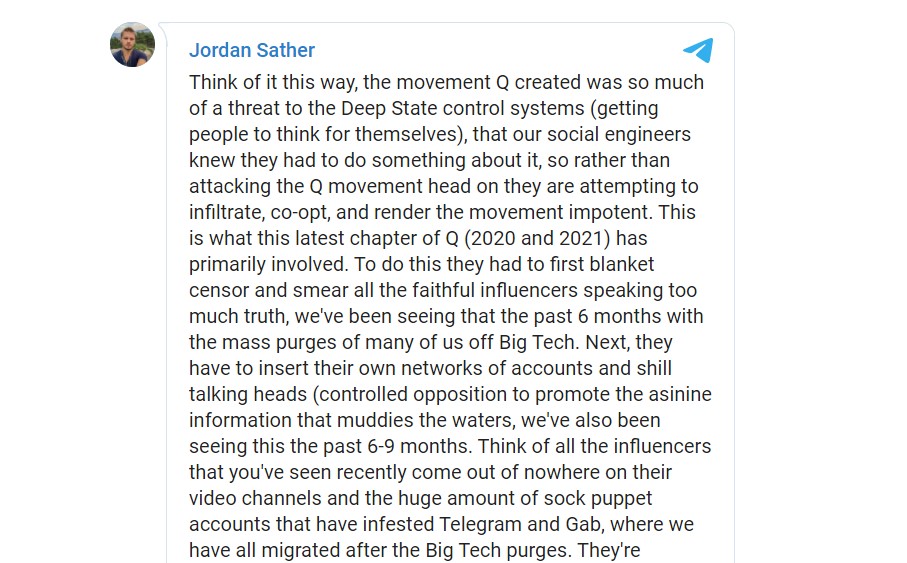QAnon is rebranding

A few minutes every morning is all you need.
Stay up to date on the world's Headlines and Human Stories. It's fun, it's factual, it's fluff-free.
“There is Q and there are Anons but there is no QAnon” has now become a rallying cry of sorts, a refutation of all outlets that insist on labeling QAnon a movement.
First it was November 3, then January 6. After those dates didn’t result in a victory for former President Donald Trump, January 20 was supposed to finally bring things to a head. But the inauguration of President Joe Biden went ahead without a hitch. Now, March 4 has passed and yet one more circled date in the QAnon mythos has come and gone and nothing has happened.
There’s always March 20. When that date passes uneventfully, there will remain the indefinite future and the promise of unseen actions moving pieces into place. Though the movement began with a prediction that never came to pass – the arrest of former Secretary of State Hillary Clinton – many of the anonymous followers of Q have not lost the faith.
They have, though, grown contemptuous of the media attention on QAnon. Once heralded as proof of the movement’s relevance, the Anons (as they call themselves) now dismiss media coverage and insist “QAnon” is nothing but manufactured hysteria. They haven’t rejected Q or the beliefs, but they are seeking to distance themselves from “QAnon” and rebrand themselves as anything but a cult.
Like Pizzagate before it (which was essentially a precursor to QAnon), whatever the adherents of Q call themselves, the movement and its core beliefs do not seem to be going away anytime soon.
“There is no QAnon”
This effort at rebranding was telegraphed more than half a year ago when the anonymous poster known as “Q” (believed by many in the movement to be a government or military insider) began directing their followers to intentionally obscure the Q origins of the movement. These loyal adherents were warned to “camouflage” themselves as they prepared for an oncoming battle.
Obscuring QAnon was both a survival tactic and a way to grow the movement’s reach. In 2020, social media platforms were actively removing QAnon-affiliated accounts and other conspiracy theory groups, partially for their role in spreading misinformation about COVID-19.
Simultaneously, by avoiding imagery and hashtags like #WWG1WGA (“where we go one, we go all”) known to be affiliated with QAnon, the movement could attract followers who were drawn in by the focus on protecting children. Indeed, QAnon followers hijacked the #SaveTheChildren hashtag to spread their conspiracy theories with the clout of a genuine organization.
The result has been the spread of QAnon rhetoric by people who would never claim any allegiance to the movement, even those who would mock it as ridiculous. A poll from October 2020 found that 50% of Republicans believed “top Democrats are involved in elite child sex-trafficking rings” the core tenet of QAnon. Yet only 18% said they thought QAnon was true.
“There is Q and there are Anons but there is no QAnon” has now become a rallying cry of sorts, a refutation of all outlets (such as this one) that insist on labeling QAnon a movement. Indeed, as QAnon has garnered greater national attention (HBO is releasing a documentary, “Q: Into the Storm,” on March 21), the adherents have pushed back on the reporting.
For instance, there was the QAnon-birthed idea that Trump would be inaugurated on March 4, based on a convoluted conspiracy theory that says the United States incorporated in 1871 and the original inauguration day (March 4) was never legally changed to January 20. When the media began reporting on this theory, Q followers denounced it as either a trap or an intentional effort to discredit them.
With the elaborate prophecies of Q (who hasn’t posted since 2020) having gone unrealized, many have grown disenchanted with the movement, but others insist the fight continues. The Anons who still believe are blaming the movement’s apparent failures on infiltration efforts by the same “Deep State” that Trump was purportedly fighting.
Who is Jordan Sather?
Jordan Sather, one of the many Q adherents who turned to Telegram (and other unregulated platforms) in the wake of the social media crackdown, is a leading voice of QAnon’s current moment. Like many before him, Sather has used the QAnon movement to boost his influence and grow an audience.
One of Sather’s recurring arguments is that much of what is now being branded as “QAnon” is intentional disinformation made to either infiltrate the movement or make it look bad.
In a typically lengthy Telegram post from March 11, Sather claims, “the movement Q created was so much of a threat to the Deep State control systems (getting people to think for themselves), that our social engineers knew they had to do something about it, so rather than attacking the Q movement head on they are attempting to infiltrate, co-opt, and render the movement impotent.”

Sather is also active on Rumble, the video-hosting site that conservatives and far-right figures have turned to as an alternative to YouTube. In one video, posted on February 14, Sather stands in front of a white board that states in three separate boxes, “There is ‘Q’,” “There are ‘Anons’” and “There is NO ‘QAnon’.”
Sather says the term “QAnon” is “being used to undermine Q and to undermine the truth seekers out there who are researching and discussing Q.” Q is not a person, Sather insists, but an “information dissemination program … whereby some group that was close to President Trump was putting posts on the internet from about October 2017 to the last one being December 2020.”
Anons are the people who have been reading and interpreting the Q posts (“Q drops”) and then disseminating them. Sather calls this “doing the groundwork.” Acknowledging that the phrase “QAnon” began as a hashtag among the Anons, Sather insists it was a term of convenience, but it is not a group or organization. He calls its current usage a media “strawman.”
“QAnon” is broadly defined as an online movement of conspiracy theorists who are united by their belief in the messages of Q. Though QAnon believers have organized public protests, it was never suggested the movement was a centralized organization.
It remains unknown whether this effort to shed the QAnon label will help the movement lose its public black eye.
Anonymous vs QAnon
By actively distancing themselves from the QAnon label and rebranding as nothing but an anonymous movement, the Q adherents are aligning themselves with Anonymous, the online hacktivist group whose signature image is a Guy Fawkes mask.
Like QAnon, Anonymous is concerned with sex trafficking, pedophilia and exposing the powerful figures behind such acts. One subgroup of Anonymous is the OpDeathEaters, founded in 2014 by Human rights activist Heather Marsh. Per its Twitter account, “The objective of #OpDeathEaters is an independent, international, victim-led tribunal/inquiry into trafficking and paedosadist industry.”
Whereas Anonymous seeks to root out sex traffickers in whatever corners they may be found, QAnon is singularly focused on its belief that Democrats and Hollywood elites are a cabal of Satanic, cannibalistic pedophiles. This political bias is key to the belief that Trump was the man who would bring down the cabal, despite his close ties to known child sex trafficker Jeffrey Epstein.
For that reason, OpDeathEaters has explicitly distanced itself from the movement. The US arm states in its Twitter bio, “If you’re PizzaGate, MAGA or Qanon unfollow now.” The main account has repeatedly called QAnon a “decoy op,” or, in other words, an intentional disinformation campaign to discredit real victims and genuine efforts to expose sex trafficking networks.
The OpDeathEaters express sympathy for victims of sexual abuse who have found comfort in QAnon but minces no words about how they see the movement: “Conspiracy pits like Qanon are designed to discredit victims and add to existing trauma by surrounding them with ridicule and disbelief. Classic cult stuff.”
Public activists who have been working for decades to end sex trafficking are also critical of QAnon. These activists say the movement wildly misrepresents the reality of child sex abuse, ignoring that most sexual abuse happens near to home. The existence of QAnon has also led to increased incidents of false reporting that waste valuable resources and time for real organizations.
Have a tip or story? Get in touch with our reporters at tips@themilsource.com




Comments ()